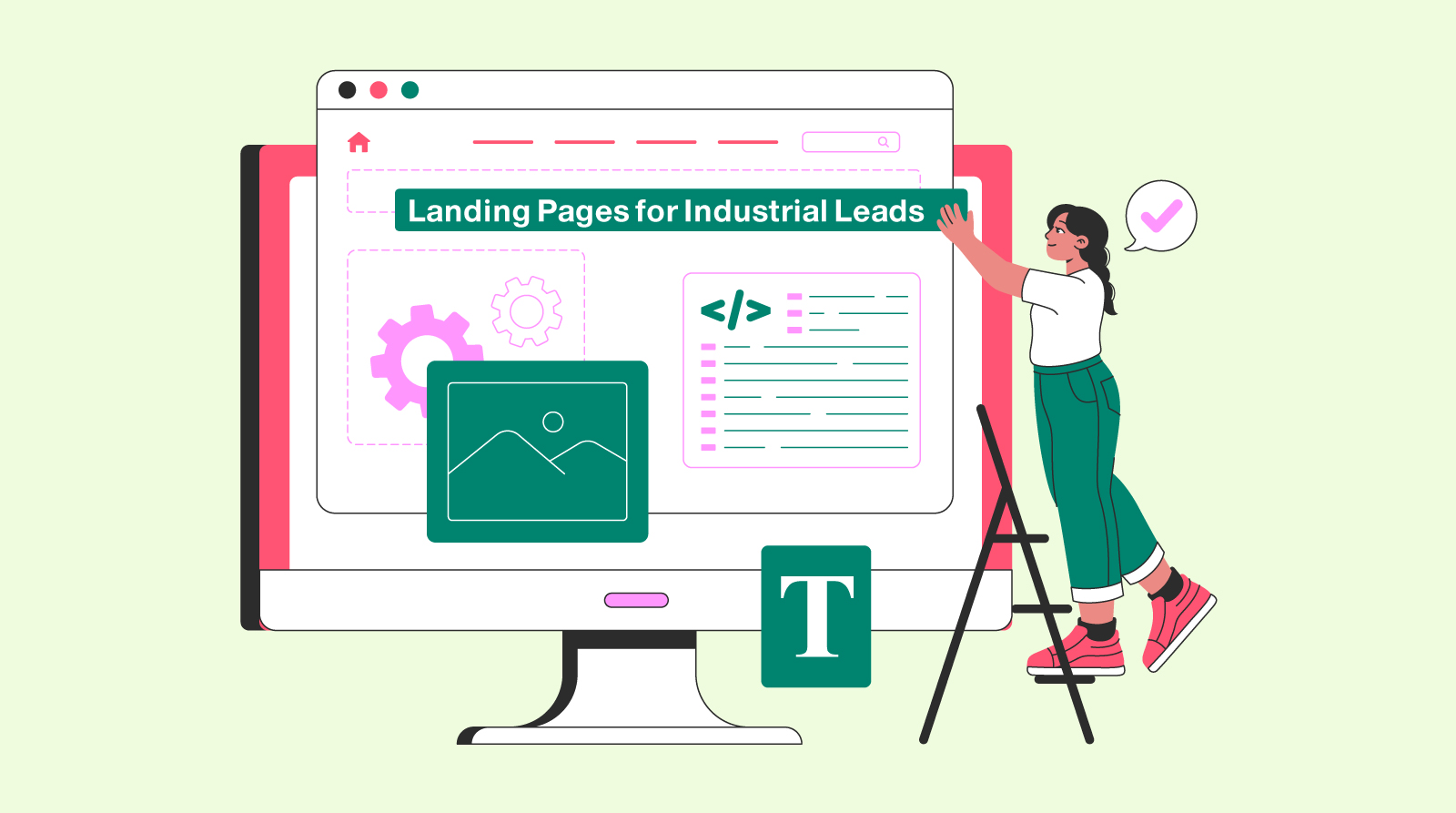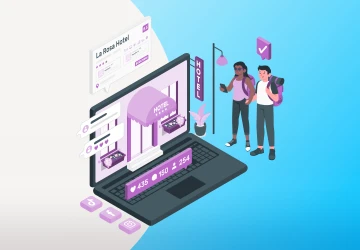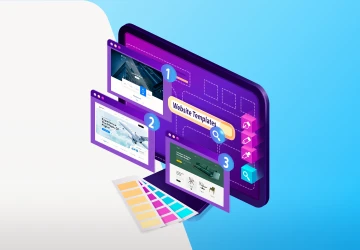Landing Pages for Industrial Companies: Boost Qualified Leads

Landing pages for industrial companies often stumble because they try to do it all instead of one thing: Convert clicks into contacts.
Engineers and procurement teams aren’t impressed by generic layouts—they crave focused sales pages that speak directly to their needs.
Think of your landing page like a laser: It targets a single action, cuts through distractions, and captures interest.
In this guide, I’ll reveal the key tactics for crafting offers, layouts, and forms that turn every visit into a win for your B2B lead generation goals.
What Is the Role of Landing Pages in Industrial Lead Generation?
Landing pages for industrial companies have one main goal: To turn visitors into leads.
That’s it.
They’re not there to look pretty or explain everything about your business.
They’re there to get people to take action, like downloading a white paper or signing up for a webinar.
I once came across a great golf analogy that nails it.
Think of your landing page as the putting green.
You’ve already done the hard work driving the ball (your potential lead) down the fairway.
Now the goal is simple—get that ball into the hole.
In other words, guide your visitor to take the action you want, like filling out a short form or requesting a quote.
Now, here’s where it gets interesting—your regular Contact Us page isn’t a landing page. Why?
Because most people aren’t ready to get in touch right away.
They want something first—something useful.
That’s where a well-built landing page shines.
It gives them a specific offer they care about, like a how-to guide or an industry report.
In return, they share their name and email.
Boom—B2B lead generation in action.
This laser-sharp focus is what sets landing pages for industrial companies apart.
While a normal web page might try to do five different things, a landing page keeps it simple: Offer value, get a lead.
No distractions, no confusion.
Of course, the design still matters.
But it’s not about making things flashy.
It’s about being clear, helpful, and focused.
That’s what makes these sales pages so effective in driving real results.
What Are the Most Common Mistakes to Avoid on Industrial Landing Pages?
Let’s be real—landing pages for industrial companies often miss the mark.
And from what I’ve seen with manufacturing and engineering firms, the issues usually aren’t complex.
Here are the top pitfalls and how you can dodge them with just a bit of planning:
Traffic Going to the Homepage Instead of a Landing Page: Imagine clicking an ad expecting a clear offer, then landing on your busy homepage. Confusing, right? Always point links from marketing campaigns directly to your focused sales pages, not your general site.
More Than One Call to Action: “Download now,” “Request a quote,” “Watch our demo”—all on the same page? That’s like giving prospects three different doors and hoping they choose one. Pick a single, crystal‑clear action and make it impossible to miss.
Distracting Navigation Menus: Top bars, sidebars, footer links—it’s easy for visitors to wander off. Strip out anything that doesn’t help them convert. A true landing page keeps the path to your form straight and narrow.
No Compelling Offer: If the page just says “Contact us,” you’re asking people to do work without giving anything in return. Instead, offer something engineers want—like a downloadable white paper, case study, or ROI calculator—so they feel it’s worth sharing their info.
Forms That Ask for Too Much: Name, email, phone, company size, job title, project budget… whoa! Long forms scare prospects away. Start with the bare minimum—usually just name and email—and you can always gather more details later.
Cluttered Layout: Too many images, walls of text, competing sections—all of it dilutes your message. Keep the design clean, the headline bold, and the form front and center so visitors know exactly what to do next.
Why Do Landing Pages Have High Bounce Rates in the Industrial Sector?
We’ve all been there—your shiny new landing page gets clicks, but almost nobody sticks around.
According to Instapage, “9 out of 10 visitors bounce from the average post-click landing page.” Ouch.
And a “post-click landing page” is simply a standalone page (no site navigation) built just to get someone to act—sign up, download, buy, you name it.
So why do so many landing pages for industrial companies lose visitors before they convert?
Here are three simple questions to ask yourself:
Does my offer match expectations? If someone clicks an ad promising a detailed case study but lands on a generic brochure, they’ll hit back fast.
Does my headline feel like clickbait? Engineers and procurement teams aren’t in the mood for hype. If your headline overpromises, they’ll bounce before they even read the first sentence.
Am I targeting the right audience? Casting too wide a net means many visitors won’t see anything relevant. That wasted traffic spikes your bounce rate—and wastes marketing budget.
If you answer these questions, your landing page will be like a secret handshake—it guides your ideal prospect straight to you.
Why Do Engineers Resist Filling Out Forms on Industrial Landing Pages?
As an engineer, I tell you—long forms are the fastest way to lose us.
The moment I see a form asking for my phone number, company size, and project budget just to download a PDF, I’m out.
Why do you need all that just to share a guide?
Engineers are naturally skeptical.
We don’t hand over information unless there’s a clear reason—and even then, only the basics.
Name, email, maybe job title?
Sure.
But anything beyond that feels excessive, especially if it’s marked as required. That’s when we either bounce… or fill in junk data just to get what we need.
And we’re not alone.
So if your landing pages for industrial companies are drowning in form fields, you’re pushing away the very leads you're trying to capture.
Keep your sales pages lean and your ask minimal. 
What Type of Content Do Engineers Prefer on Landing Pages?
As someone who’s worked with and marketed to engineers, I’ll tell you—if your landing pages aren’t offering genuinely useful content, they’re getting ignored.
Engineers are busy, detail-oriented, and allergic to fluff. If your content doesn’t help them do their job better, they’re not giving you their info.
So, what works?
It’s all about technical depth and practical value.
Engineers will gladly fill out a form if it means getting access to:
White papers that dig into real-world engineering challenges and offer smart solutions
CAD drawings that they can plug directly into their projects
Case studies that walk through the success of similar companies or applications
Video tutorials that teach, not pitch
Webinars that deliver expert-level insights
Downloadable CAD files are especially powerful—they don’t just inform, they help your parts and components get “designed in” from the start.
That’s a massive win in the industrial world, because once you’re in the design, you’re in the BOM… and way closer to the sale.
And don’t overlook newsletters.
Engineers may not shout it from the rooftops, but they do value consistent, insightful updates, as long as the content is genuinely helpful.
No buzzwords. No salesy fluff. Just straight-up value.
FAQs
What Are the Three Types of Landing Pages?
The three types are standalone landing pages, in-website landing pages, and microsites—each designed based on purpose and hosting setup. Standalone focuses on conversions, website pages, support functions, and microsites that target specific campaigns.
What Is a Lead Capture Landing Page?
It’s a landing page designed to collect visitor information like name and email. This data is typically exchanged for valuable content or offers.
What Is the Difference Between a Landing Page and a Lead Page?
All lead pages are landing pages, but not all landing pages focus on lead generation. Lead pages specifically aim to collect user information for future marketing.
How Much Do Leadpages Cost?
Leadpages pricing starts around $49/month for the standard plan. Higher tiers offer advanced features like A/B testing and integrations.
Final Thoughts
Now we’ve come full circle and seen what makes high‑converting sales pages work for B2B lead generation.
Here’s a pro tip: Audit form analytics every quarter to remove underperforming fields and introduce dynamic fields based on visitor behavior – it boosts completion rates by 20% or more.
Pair that with A/B testing headlines against user session recordings, and you’ll turn passive clicks into active leads.
Ready to transform your results?
Reach out today for a custom landing page audit and watch your qualified lead count climb.







